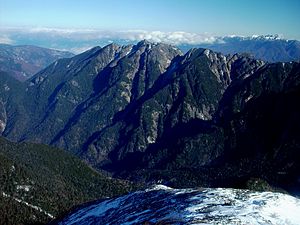Taiheiyo montane deciduous forests
| Ecoregion: Taiheiyo montane deciduous forests | |
|---|---|
 Mount Nokogiri from Kosenjo | |
 Ecoregion territory (in purple) | |
| Ecology | |
| Realm | Palearctic |
| Biome | Temperate broadleaf and mixed forests |
| Geography | |
| Area | 41,957 km2 (16,200 sq mi) |
| Country | Japan |
| Coordinates | 35°45′N 137°45′E / 35.75°N 137.75°E |
The Taiheiyo montane deciduous forests ecoregion (WWF ID:PA0441) stretches for about 700 km along the eastern (Pacific side) slopes of the island of Honshu, with some small patches on the southern islands of Shikoku and Kyushu. Lower elevations to the east along the coast are in the Taiheiyo evergreen forests ecoregion; higher elevations to the west are in the Nihonkai montane deciduous forests ecoregion. Characteristic forests are of Japanese beech, stone pine, and spruce.[1][2]
Location and description
Elevations run from sea level to 3,000 metres (9,800 ft), with a mean elevation of 680 metres (2,230 ft). While most of the ecoregion is represented by a thin strip above the coastal region, there is a large inland section centered on the Akaishi Mountains in central Honshu, and another centered on Fukushima Prefecture to the north.[3]
Climate
The climate of the ecoregion is Humid continental climate, warm summer (Köppen climate classification (Dfb)). This climate is characterized by large seasonal temperature differentials and a warm summer (at least four months averaging over 10 °C (50 °F), but no month averaging over 22 °C (72 °F).[4][5]
Flora and fauna
Japanese beech (Fagus crenata), is a characteristic tree in the northeast of the region, up to 1,400 metres (4,600 ft). Other trees include the Japanese stone pine (Pinus pumila) and Hemlock spruce (Picea). Typical understory is the Saga plant.[1]. Large mammals in the ecoregion includes the Japanese serow, Sika deer, and Wild boar.
Protected areas
Protected areas in the ecoregion include:
- Minami Alps National Park, a rugged area in the Akaishi Mountains of central Honshu, with many peaks over 3,000 meters.
- (Portions of) Fuji-Hakone-Izu National Park, in the mainland portions below Mount Fuji, which itself is in the Honshu alpine conifer forests ecoregion where it rises above the surrounding Taiheiyo ecoregion.
References
- ^ a b "Eastern Asia: Eastern Japan, stretching southward". World Wildlife Federation. Retrieved July 17, 2020.
- ^ "Map of Ecoregions 2017". Resolve, using WWF data. Retrieved September 14, 2019.
- ^ "Taiheiyo montane deciduous forests". Digital Observatory for Protected Areas. Retrieved July 17, 2020.
- ^ Kottek, M., J. Grieser, C. Beck, B. Rudolf, and F. Rubel, 2006. "World Map of Koppen-Geiger Climate Classification Updated" (PDF). Gebrüder Borntraeger 2006. Retrieved September 14, 2019.
{{cite web}}: CS1 maint: multiple names: authors list (link) CS1 maint: numeric names: authors list (link) - ^ "Dataset - Koppen climate classifications". World Bank. Retrieved September 14, 2019.
